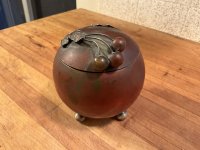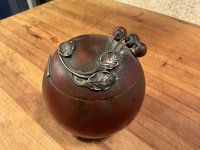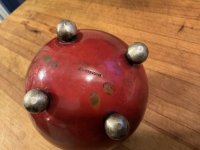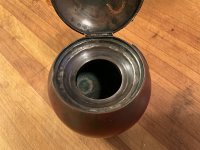bigcaddy64
Hero Member
I was out doing some saturday morning yard sales when I stumbled upon another great sale of a guy clearing out tons of really old stuff that belonged to his grandfather.
Amid the tables filled with interesting treasures, this little apple shaped piece just hypnotized me. After working out pricing for my finds it spent the rest of the day in a box until I could get home at investigate further.
It’s beautifully made of copper with some type of applied finish. It’s not enamel but it looks metallic in the sunlight The leaves and ball feet are silver as is the inner support ring. It’s missing the glass insert but I can find one to slip inside. There’s a few dents but I can work those out with my nylon hammers so it’s a bit more stable on a flat surface. .
There’s not obvious hallmark aside from the cursive “L“ and the Silver & Copper stamp.
The makers mark is irrelevant because I’m going to keep the little gem on my bookcase for a long time
Amid the tables filled with interesting treasures, this little apple shaped piece just hypnotized me. After working out pricing for my finds it spent the rest of the day in a box until I could get home at investigate further.
It’s beautifully made of copper with some type of applied finish. It’s not enamel but it looks metallic in the sunlight The leaves and ball feet are silver as is the inner support ring. It’s missing the glass insert but I can find one to slip inside. There’s a few dents but I can work those out with my nylon hammers so it’s a bit more stable on a flat surface. .
There’s not obvious hallmark aside from the cursive “L“ and the Silver & Copper stamp.
The makers mark is irrelevant because I’m going to keep the little gem on my bookcase for a long time






